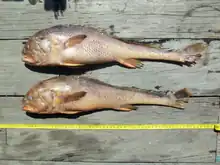Panna (fish)
Panna is a genus of marine ray-finned fish belonging to the family Sciaenidae, the drums and croakers. These fishes are found in southern and southeast Asia.
| Panna | |
|---|---|
 | |
| Armour croaker (Panna perarmatus) | |
| Scientific classification | |
| Domain: | Eukaryota |
| Kingdom: | Animalia |
| Phylum: | Chordata |
| Class: | Actinopterygii |
| Order: | Acanthuriformes |
| Family: | Sciaenidae |
| Genus: | Panna R. S. Lal Mohan, 1969 |
| Type species | |
| Otolithus microdon | |
Taxonomy
Panna was first proposed as a monospecific genus in 1969 by the Indian ichthyologist R. S. Lal Mohan with Otolithus microdon designated as its type species, as well as being the only species.[1] O. microdon was described in 1849 by Pieter Bleeker, with its type locality given as Java.[2] The genus Pachyurus is included in the subfamily Cynoscioninae by some workers,[3] but the 5th edition of Fishes of the World does not recognise subfamilies within the Sciaenidae, which it places in the order Acanthuriformes.[4]
Etymology
Panna is a name that Lal Mohan did not explain but is thought to be a local name of the type species, P. macrodon in India.[5]
Species
There are currently 3 recognized species in this genus:[6]
Characteristics
Panna croakers have a swim bladder characterised by having a pair of tubular appendages starting at the head end which divides almost at its root into a simple rear part and either a simple or branched part at the head end, entering the head through the septum transversum.[7] The maximum published standard lengths of Panna croakers varies from 21.4 cm (8.4 in) in P. heterolepis and 50 cm (20 in) in P. perarmatus.[6]
Distribution
Panna croakers are found in the Indo-West Pacific with P. heterolepis being found off India, Sri Lanka, Bangladesh and Myanmar; P. microdon is found in eastern Malaysia in Perak, the Gulf of Thailand, Vietnam, Borneo, eastern Sumatra and Java; and P. perarmatus is foundd off Vietnam, in the Gulf of Thailand and Borneo.[7]
References
- Eschmeyer, William N.; Fricke, Ron & van der Laan, Richard (eds.). "Genera in the family Sciaenidae". Catalog of Fishes. California Academy of Sciences. Retrieved 14 June 2023.
- Eschmeyer, William N.; Fricke, Ron & van der Laan, Richard (eds.). "Species in the genus Panna". Catalog of Fishes. California Academy of Sciences. Retrieved 14 June 2023.
- Kunio Sasaki (1989). "Phylogeny of the family Sciaenidae, with notes on its Zoogeography (Teleostei, Peciformes)" (PDF). Memoirs of the Faculty of Fishes Hokkaido University. 36 (1–2): 1–137.
- J. S. Nelson; T. C. Grande; M. V. H. Wilson (2016). Fishes of the World (5th ed.). Wiley. pp. 497–502. ISBN 978-1-118-34233-6.
- Christopher Scharpf & Kenneth J. Lazara, eds. (9 March 2023). "Series Eupercaria (Incertae sedis): Families Callanthidae, Centrogenyidae, Dinopercidae, Emmelichthyidae, Malacanthidae, Monodactylidae, Moronidae, Parascorpididae, Sciaenidae and Sillagidae". The ETYFish Project Fish Name Etymology Database. Christopher Scharpf and Kenneth J. Lazara. Retrieved 14 June 2023.
- Froese, Rainer and Pauly, Daniel, eds. (2023). Species of Panna in FishBase. February 2023 version.
- Sasaki, K. (1995). "A review of the Indo-West Pacific sciaenid genus Panna (Teleostei, Perciformes)". Japanese Journal Ichthyology. 42 (1): 27–37.